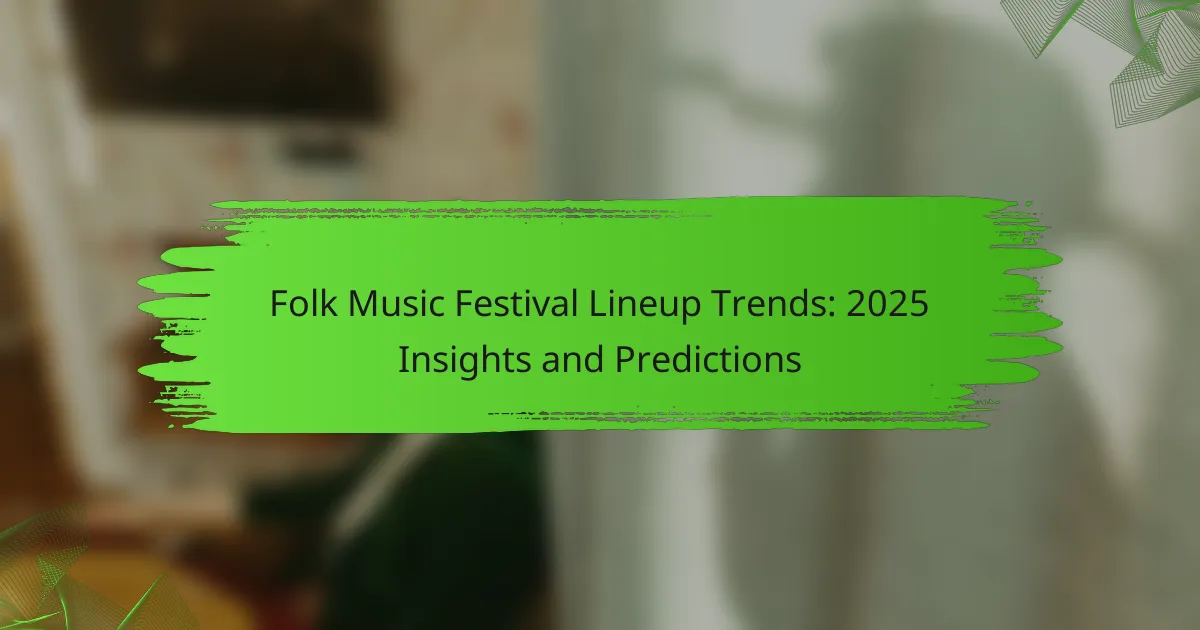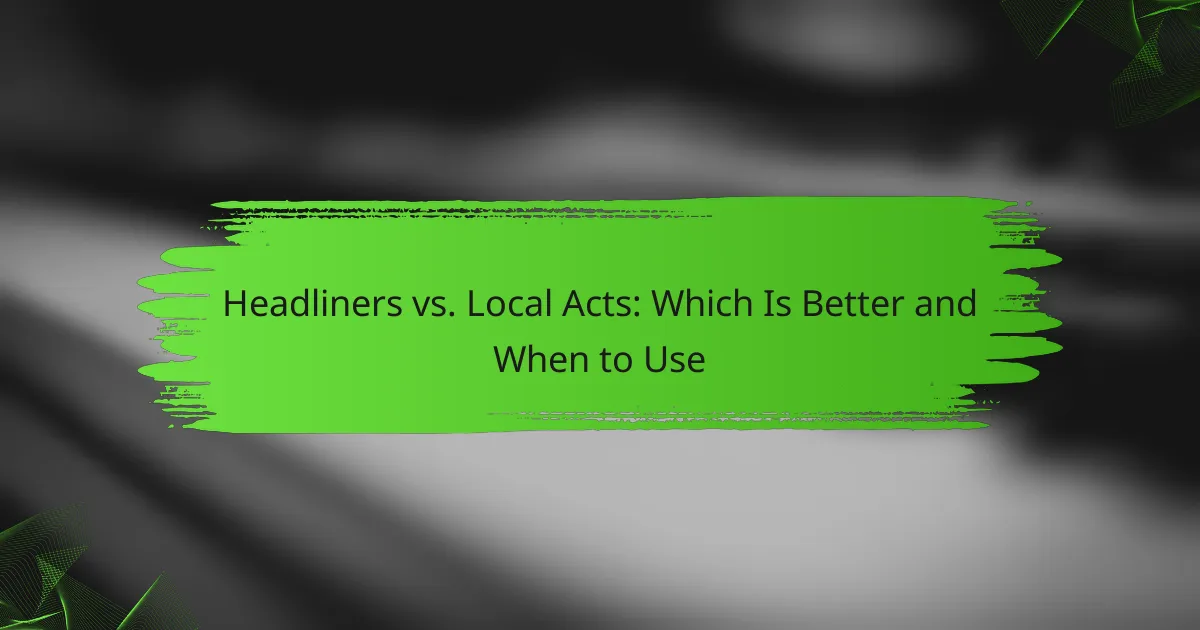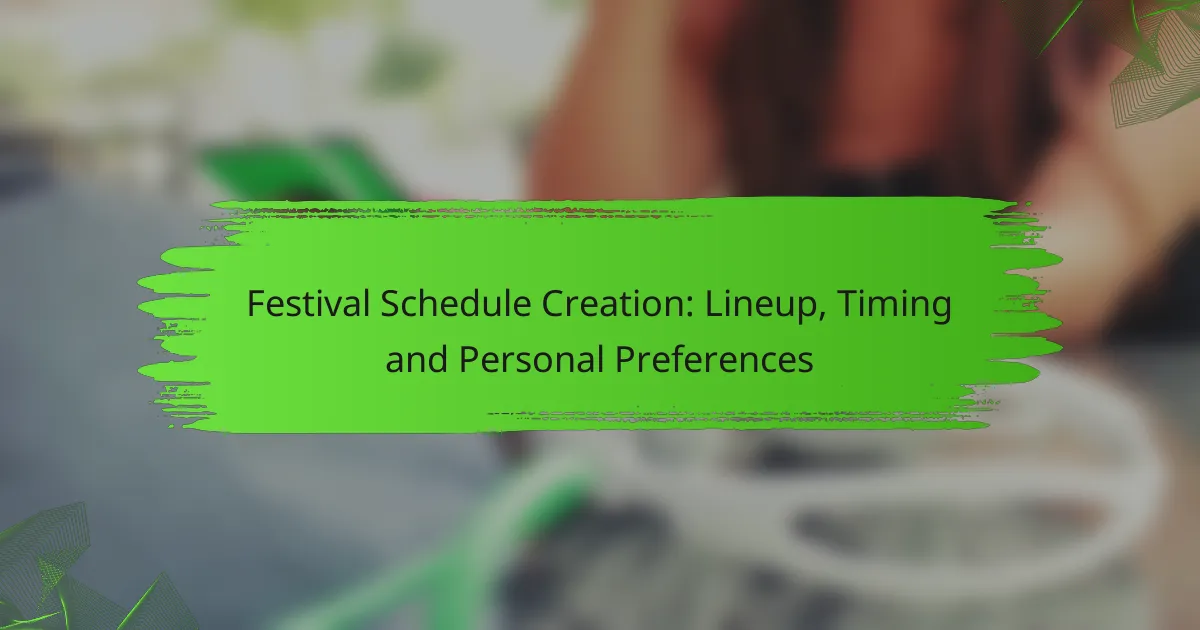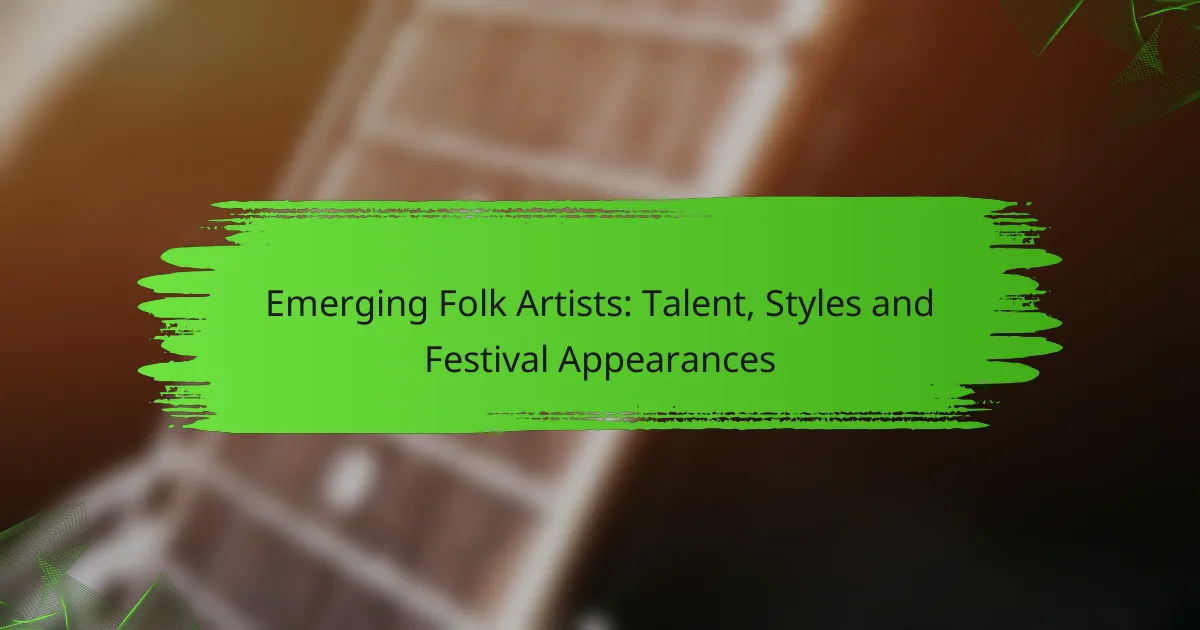As we look ahead to 2025, folk music festivals are set to feature an exciting array of artists and genres, reflecting a commitment to diversity and community engagement. Major events like the Newport Folk Festival and MerleFest are adapting to audience preferences and technological advancements, ensuring a more inclusive and sustainable festival experience. These trends highlight the evolving landscape of folk music, where cultural shifts are shaping the sounds and experiences that resonate with attendees.
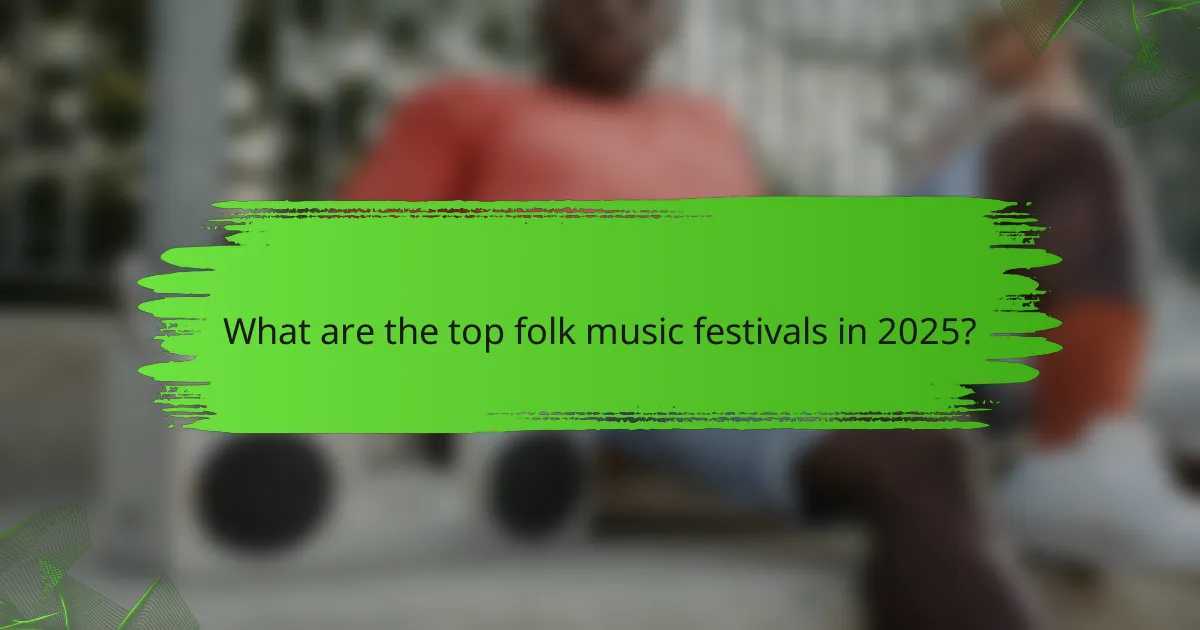
What are the top folk music festivals in 2025?
In 2025, the top folk music festivals showcase a diverse lineup of artists and genres, attracting large audiences and fostering community engagement. Key festivals include the Newport Folk Festival, MerleFest, Philadelphia Folk Festival, Woodstock Folk Festival, and the American Folk Festival, each offering unique experiences and musical traditions.
Newport Folk Festival
The Newport Folk Festival, held annually in Rhode Island, is renowned for its rich history and commitment to folk music. In 2025, expect a blend of established artists and emerging talents, with performances often taking place on multiple stages throughout the event.
Attendees can enjoy not only music but also workshops and discussions that delve into the cultural significance of folk traditions. The festival typically features a mix of genres, including Americana, bluegrass, and singer-songwriter performances.
MerleFest
MerleFest, located in Wilkesboro, North Carolina, is one of the largest and most celebrated folk festivals in the United States. In 2025, the festival will continue to honor the legacy of Merle Watson, featuring a lineup that emphasizes traditional and contemporary folk music.
With a focus on acoustic music, MerleFest offers a variety of performances, workshops, and activities for all ages. The festival is known for its family-friendly atmosphere and often includes genres like country, blues, and roots music.
Philadelphia Folk Festival
The Philadelphia Folk Festival is a staple in the folk music scene, celebrated for its vibrant community and diverse lineup. In 2025, attendees can expect a mix of local and international artists, showcasing various folk styles and cultural influences.
This festival typically features multiple stages, food vendors, and craft booths, creating a festive environment. The Philadelphia Folk Festival also emphasizes sustainability and community involvement, making it a unique experience for music lovers.
Woodstock Folk Festival
The Woodstock Folk Festival, held in the historic town of Woodstock, New York, continues to celebrate the spirit of the original 1969 festival. In 2025, the event will feature a lineup of both legendary and up-and-coming folk artists, reflecting the genre’s evolution.
Attendees can enjoy intimate performances in a picturesque setting, often accompanied by art exhibits and local crafts. The festival promotes a sense of community and connection to the roots of folk music.
American Folk Festival
The American Folk Festival, hosted in Bangor, Maine, is known for its commitment to showcasing traditional music from various cultures. In 2025, the festival will highlight a range of folk traditions, offering a platform for artists from diverse backgrounds.
This festival typically features multiple stages, food from local vendors, and activities that engage the community. The American Folk Festival aims to educate attendees about the cultural significance of folk music while providing an enjoyable experience for all.
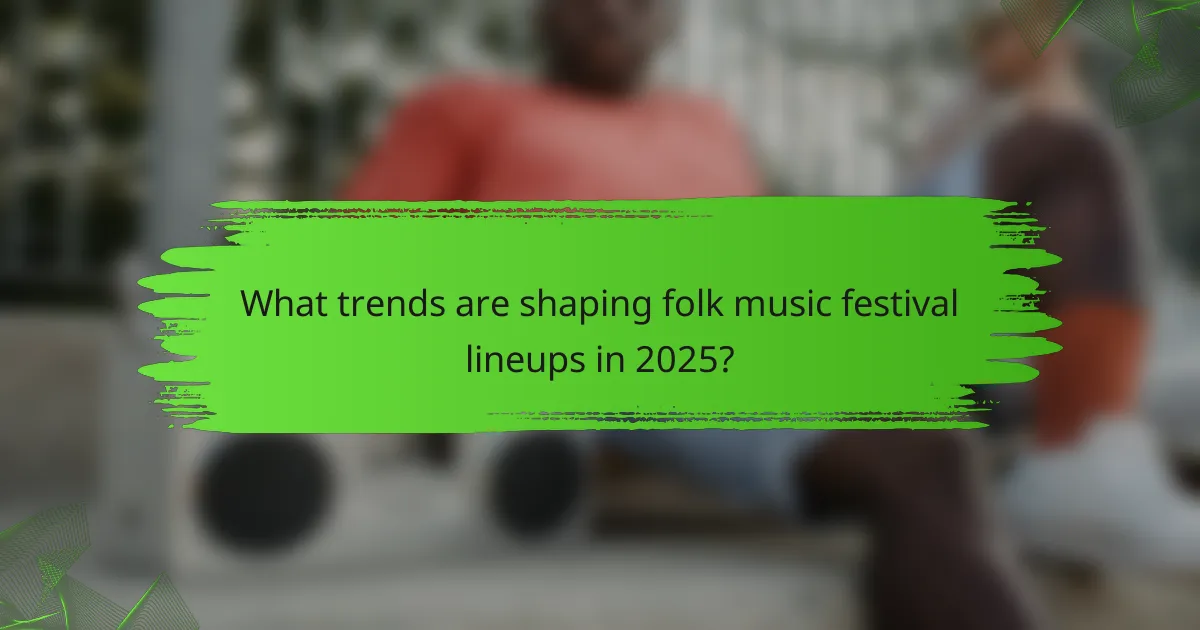
What trends are shaping folk music festival lineups in 2025?
In 2025, folk music festival lineups are increasingly influenced by diversity, sustainability, and technology. These trends reflect a broader cultural shift towards inclusivity, environmental responsibility, and innovative performance experiences.
Diversity in artist representation
Diversity in artist representation is becoming a cornerstone of folk music festivals. Organizers are prioritizing lineups that feature artists from various backgrounds, including different ethnicities, genders, and musical styles. This approach not only enriches the festival experience but also attracts a wider audience.
Festivals are increasingly showcasing underrepresented voices, which can include Indigenous musicians, [censured] artists, and those from various cultural traditions. This shift encourages collaboration and cross-genre experimentation, leading to unique performances that resonate with diverse audiences.
Increased focus on sustainability
Sustainability is a growing priority for folk music festivals, with many organizers implementing eco-friendly practices. This includes reducing waste, using renewable energy sources, and promoting local food vendors to minimize carbon footprints. Festivals are also encouraging attendees to use public transport or carpool to reduce emissions.
Some festivals are adopting green certifications, which can enhance their appeal to environmentally conscious attendees. By prioritizing sustainability, festivals not only contribute to environmental preservation but also foster a community of like-minded individuals who value ecological responsibility.
Integration of technology in performances
Technology is increasingly integrated into folk music performances, enhancing the audience experience. This includes the use of live streaming, augmented reality, and interactive apps that allow attendees to engage with artists and each other. Such innovations can expand the reach of festivals beyond physical attendees.
Additionally, artists are utilizing technology for creative expression, incorporating electronic elements into traditional folk music. This fusion can attract younger audiences and keep the genre evolving while still honoring its roots. Festivals that embrace these technological advancements can create memorable experiences that resonate with a tech-savvy crowd.
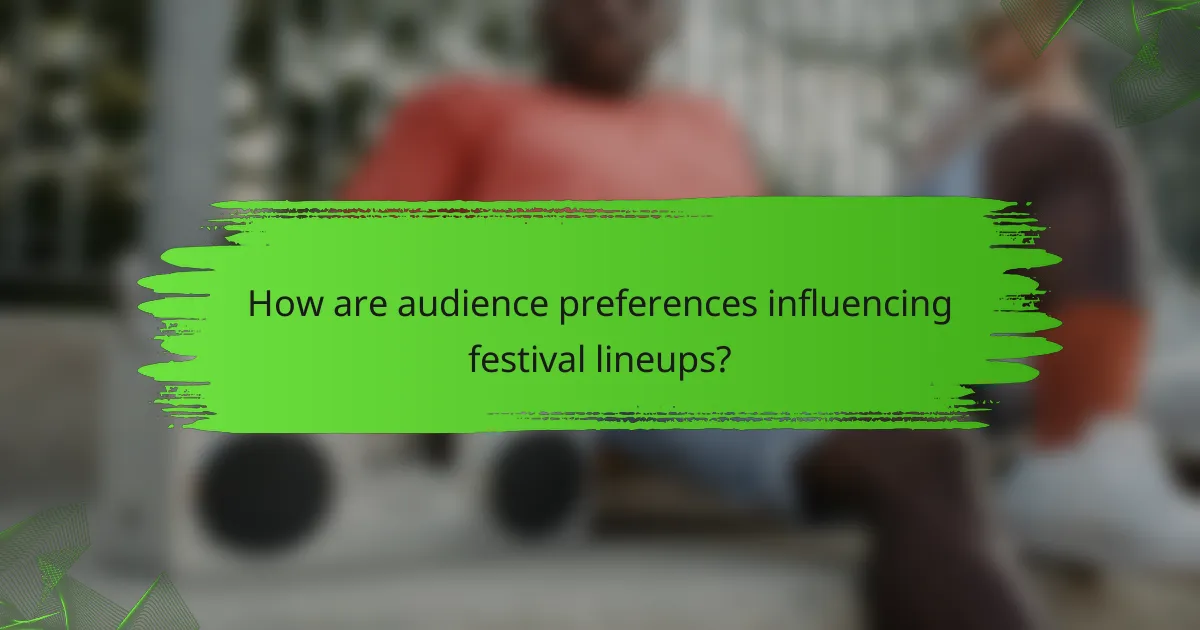
How are audience preferences influencing festival lineups?
Audience preferences are significantly shaping festival lineups by driving demand for specific types of artists and experiences. As festival-goers become more discerning, their tastes influence which acts are booked, leading to a more tailored and engaging festival experience.
Demand for local artists
There is a growing trend towards featuring local artists in festival lineups, as audiences increasingly seek to support homegrown talent. This not only fosters community engagement but also enhances the festival’s cultural relevance. Festivals that prioritize local acts often see higher attendance and stronger connections with their audience.
Booking local artists can also be cost-effective, as they typically require lower fees compared to international headliners. This allows festivals to allocate budgets towards enhancing other aspects of the event, such as production quality or interactive experiences.
Popularity of genre-blending acts
Genre-blending acts are gaining traction as audiences crave diversity in their musical experiences. These artists often combine elements from various genres, appealing to a broader demographic and creating a unique festival atmosphere. Festivals that embrace this trend can attract a wider audience and keep the lineup fresh and exciting.
For example, a folk artist collaborating with electronic musicians can draw fans from both genres, increasing overall attendance. Festivals should consider incorporating genre-blending acts to enhance their appeal and create memorable performances.
Interest in interactive experiences
Festival-goers are increasingly interested in interactive experiences that go beyond traditional performances. This can include workshops, art installations, and immersive activities that engage attendees on multiple levels. Festivals that offer these experiences often see higher satisfaction rates and repeat attendance.
To capitalize on this trend, festivals can integrate hands-on activities related to the music or culture represented at the event. For instance, offering instrument workshops or dance classes can create a more inclusive and participatory environment, enhancing the overall festival experience.

What are the key factors for selecting artists in 2025?
In 2025, selecting artists for folk music festivals will primarily hinge on their popularity, social media presence, and past performance records. These factors help organizers ensure a compelling lineup that resonates with audiences and maximizes attendance.
Artist popularity and streaming metrics
Artist popularity is often gauged through streaming metrics, including monthly listeners and total streams on platforms like Spotify and Apple Music. Festivals may prioritize artists with a substantial following, typically in the low hundreds of thousands to millions of monthly listeners, as this indicates a strong fan base.
Organizers should also consider the growth trends in an artist’s streaming numbers. A rising artist with a consistent increase in streams can attract attention and bring fresh energy to the festival, appealing to both new and existing audiences.
Social media engagement
Social media engagement plays a crucial role in artist selection, as it reflects how well an artist connects with their audience. Metrics such as follower count, likes, shares, and comments can indicate an artist’s influence and reach. Festivals often look for artists with high engagement rates, typically above 5%, as this suggests a dedicated fan community.
Additionally, the type of content shared by artists can impact their selection. Artists who actively promote their music, share behind-the-scenes content, and interact with fans are more likely to be chosen, as they can enhance the festival’s visibility and appeal.
Previous festival performance history
Previous performance history at festivals is a key factor in artist selection. Organizers often prefer artists with a proven track record of successful performances, as this can indicate reliability and audience appeal. Artists who have consistently drawn crowds or received positive feedback from past events are more likely to be invited back.
Moreover, festivals may consider the diversity of an artist’s past performances. Artists who have successfully performed at various types of festivals, from small local events to larger national gatherings, demonstrate versatility and adaptability, making them attractive choices for organizers looking to create a well-rounded lineup.
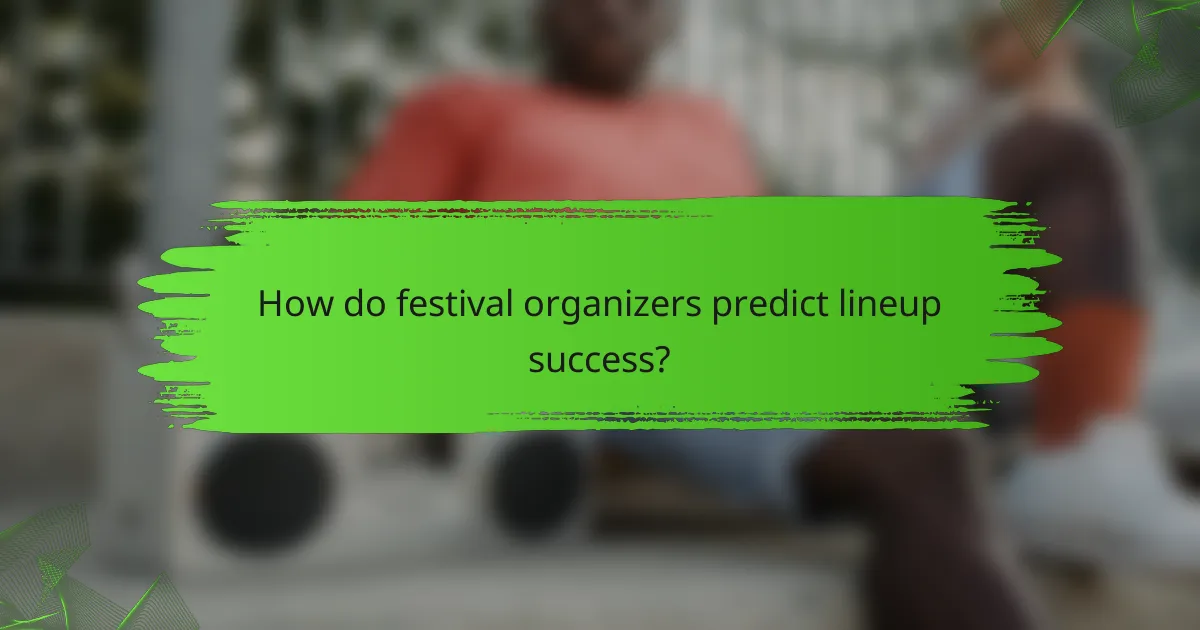
How do festival organizers predict lineup success?
Festival organizers predict lineup success by analyzing audience preferences, market trends, and historical data. They utilize various methods, including surveys and social media insights, to gauge which artists resonate most with their target demographic.
Audience surveys and feedback
Audience surveys and feedback are crucial tools for festival organizers to understand attendee preferences. By collecting data through pre-festival surveys, organizers can identify which artists or genres are most anticipated by potential attendees.
Organizers often use online platforms to distribute surveys, allowing for a broader reach. Feedback can also be gathered post-event to assess how well the lineup met audience expectations, providing valuable insights for future festivals.
To maximize the effectiveness of surveys, organizers should keep questions concise and focused. Offering incentives, such as discounts on tickets or merchandise, can increase response rates and yield more comprehensive data.
